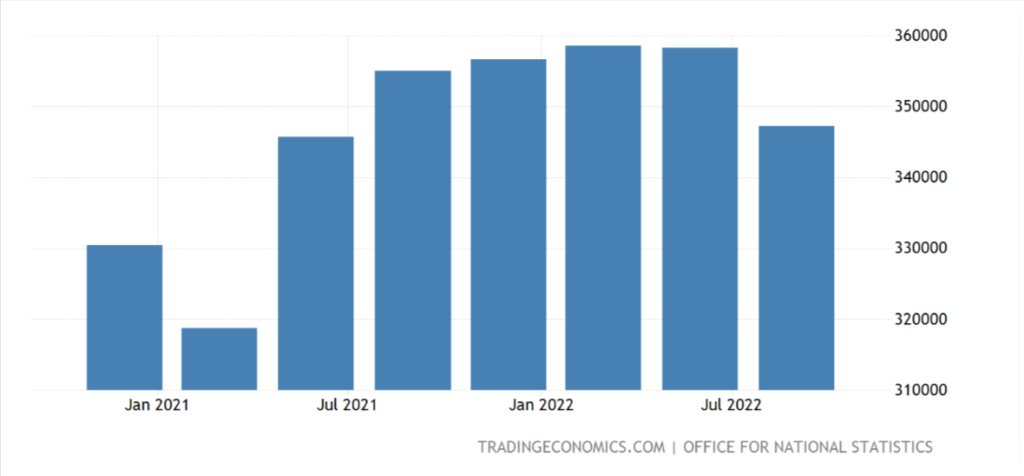- Published: 6th Dec 22
- Tags: Google's Machine Learning, PPC, Responsive Search Ads
At the beginning of 2022, it is perhaps fair to say that predictions for business seemed optimistic as the world progressed into a post-Covid climate. There were discussions of a revival of the Roaring Twenties, in which, as the world reopened, consumers would buy products, services and experiences much more freely.
Now, as we’re venturing into the Christmas season, consumers are generally presumed to be buying at a much higher rate, too. This is encouraged by things such as Black Friday Sales throughout November, the World Cup, Christmas Sales and countless other purchase-initiatives
However, due to the Ukraine war, soaring energy prices, and a volatile economic situation spending habits are being strongly impacted.

As evidenced by the graph above, we can see that from July 2022, consumer spending can be seen to dwindle. This is highly influenced by the increased living costs throughout the economy, and the depletion of disposable income, as illustrated in the following graph.
Consumer’s seem to have altered their shopping behaviour. For example, quality of the product or service being purchased is viewed as significantly more important than the price. Based on Google Trends, search terms favour the best product over the cheapest. Therefore, consumers are more likely to be on the lookout for reliability, trustworthiness and high quality in general – rather than a cheap deal. The Cost of Living Crisis highlights the intent for value further.
It is always smart to engage and keep high value, high intent audiences, but in such unprecedented times it is ideal to find and retain such valuable audiences – both for the benefit of business and consumers.
Google’s Machine Learning:
To capture high intent audiences, it would be beneficial to lean into Google’s Machine Learning technology. Google Ads’ machine learning algorithm considers multiple factors when it comes to your ads. It allows for your ads to be shown to the right people at the right time.
For this, we would strongly recommend implementing Responsive Search Ads. By supplying 15 headlines and 4 descriptions, Google tests different combinations and learns which ad creative performs the best against search queries. This ensures your ads are valuable and relevant to your audience’s search queries. According to Internal Google Data, on average, advertisers who use this machine learning to test multiple creative see up to 15% more clicks. More clicks, more conversions.
Under the same realm, introducing Local Campaigns to your account would be beneficial. Provide your business location and ad creative and Google will be able to automatically optimise the ads.
Using Smart Shopping Campaigns will also automatically optimise shopping ads. It eliminates the need for manual managing and bidding, and allows you to select multiple types of goals. Machine learning factors in the likelihood that a click will result in one of the goals and adjust bids accordingly.
These are just some of the ways in which you can incorporate Google’s Machine Learning Model into your marketing strategy in order to excel your results.
Customer Retention & Brand Loyalty:
Customer retention and brand loyalty are both great ways to maximise efficiencies. It can be more cost-effective for your business, as well as a lower-risk venture for your consumers. Audience Targeting is a useful way to retain customers, but also beneficial for finding relevant new audiences – which is always a positive endeavour. There are multiple types of segmenting and targeting available on Google Ads.
Focusing on Search Ads, there are:
Affinity Audiences: Reach users based on what they’re passionate about and their habits and interests.
Detailed Demographics: Long-term life facts.
In-Market Audiences: Reach users based on their last purchase intent.
Your Data: –
-Website and App Visitors: Reach people who have visited your website/apps.
–Customer Match: Reach your existing costumes based on your CRM match.
–Similar Segments: Reach new users with similar interests to your website visitors or existing customers.
You can set up these ways of targeting when you first create your campaign, adding them later through the audiences tab on the navigation tab in the left of the screen, or add them for individual assets.
Additionally, to maintain a high standard of customer relevance it is imperative to have an extensive list of keywords and headlines in your Responsive Search Ads. To reiterate, implementing relevant keywords with an assigned 15 headlines and 4 descriptions will allow Google to test and run different variations of Search Ads. This allows for the most responsive ones to be shown, leading to higher quality traffic and conversions. For more information on how to effectively implement Search Ads, take a look at our blog giving an insight into improving their efficiency.
There are many more ways to excel your PPC advertising and to healthily retain and engage audiences in a time when buying habits are adapting to the wider socio-economic landscape. But, as a brief overview, implementing targeting on your RSA’s, simply refreshing them, or diving into Google’s Machine Learning could boost your performance.
